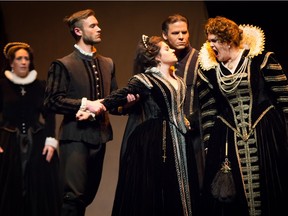Soprano gives stellar performance in Edmonton Opera's Maria Stuarda

Reviews and recommendations are unbiased and products are independently selected. Postmedia may earn an affiliate commission from purchases made through links on this page.
Article content
There is one simple reason why anyone who enjoys the operatic voice should snap up a ticket to one of the next two performances of Donizetti’s opera Maria Stuarda, which opened in Edmonton Opera’s production on Saturday.
The role of Mary, in the story of the confrontation between Queen Elizabeth and Mary Queen of Scots, is taken by a young singer who quite clearly has the potential of a stellar career ahead.
Now in her very early 30s, Kathryn Lewek has been in danger of becoming typecast as a one-role wonder, celebrated for her interpretation of the Queen of the Night. She’s sung it everywhere from the Met to English National Opera, from Leipzig to Houston.
This was her Edmonton Opera debut, and her first performance as the Scottish Queen. She showed that her voice is not only ideal for the coloratura roles, but may well be developing into the ideal for the great Italian opera dramatic soprano roles. Her upper range is gloriously pure: the bel canto decoration sounds effortless, and she has the wonderful ability to sing really high, really softly. And, as she showed in the last act, she can certainly hold those high notes.
But it is the other side of the voice that is also essential to that repertoire: the darker, emotional power of the lower range. She has it, and it moves seamlessly into the purity of the upper. This is a soprano performance of a quality that should not be missed.
Her stage presence is not yet quite as developed as her vocal presence (perhaps hardly surprising if you sing the Queen of the Night from The Magic Flute all of the time). Her chief dramatic ploy as Mary was to use that lovely, soft, high singing to allure those she wished to please or placate (and, oh, how sweetly she does it).
Fair enough, but there is more to her emotions than sweet appeal or the anger and spite she showed in the confrontation with Elizabeth. But I am sure that the physical dramatic expression will develop, especially if she has the opportunity to widen her repertoire. If it does, it will also inform the singing, creating what promises to be a formidable combination.
That she doesn’t totally steal the show is down to Donizetti, for Maria Stuarda is above all a singer’s opera, and even more an opera of dialogue and interchange.
Keri Alkema as Elizabeth I started off a bit hesitantly, but soon brought her to life, here emphasizing the woman over the Queen. Alkema is more effective showing anger or high emotions than introspection, but her performance makes an effective contrast, and complement, to Lewek’s Mary.
Of the men, baritone Jason Howard made the most of the rather one-dimensional role of Cecil. But Diego Silva, in the tenor role of Leicester, failed to convince either vocally or dramatically as a major player in the relationship between the two queens.
That the first half of Maria Lamont’s production was less successful is also partly due to Donizetti. The wonderful drama of the confrontation scene between the two Queens apart, the music is more formulaic.
The set by Camillia Koo — a single basic structure used throughout the opera — and the lighting by Geoffrey George, didn’t help. For much of the time, the blank back wall made the stage look like the rather shabby backyard of a unit on an industrial estate, and the singers seemed rather lost in such an anonymous space. Some harsh lighting only added to the effect (why the blue for the confrontation?)
All, however, was redeemed in the second half. Donizetti’s music (unobtrusively conducted by Robert Dean) is much more powerful. The marvellous opening chorus of the final scene was a model for Verdi, the orchestral writing has more power, and the flow of emotions are continuous to the very end.
Suddenly the lighting became atmospheric, with the tones of old oak and musty air. We were now visually drawn into an identifiable Elizabethan drama.
For Mary’s confession scene, four hangings each showing the famous late 15th century tapestry of the Unicorn in Captivity provided a symbolic backdrop (suggesting a parallel between the death of Mary and the death of Christ).
Only at the very end did the staging of the final act really trip up. One can understand Lamont’s decision to return to Mary staring at the symbolic portrait of Queen Elizabeth, but it was at the expense of the drama. Mary is exiting to her death in the final bars, and that much more important symbolism, and its emotional power, was lost.
No matter: go to Maria Stuarda just to hear Lewek. Move over, Queen of the Night, and Edmonton Opera, please bring her back.
Review
Maria Stuarda
Organization: Edmonton Opera
Conductor: Robert Dean
Director: Maria Lamont
Starring: Keri Alkema, Jordan Bisch, Jason Howard, Kathryn Lewek, Diego Silva, and Elizabeth Turnbull
Where: Jubilee
When: Saturday night, continues Tuesday, April 19, Thursday April 21, 7:30 p.m.
Tickets: $40-$150, edmontonopera.com






Postmedia is committed to maintaining a lively but civil forum for discussion. Please keep comments relevant and respectful. Comments may take up to an hour to appear on the site. You will receive an email if there is a reply to your comment, an update to a thread you follow or if a user you follow comments. Visit our Community Guidelines for more information.